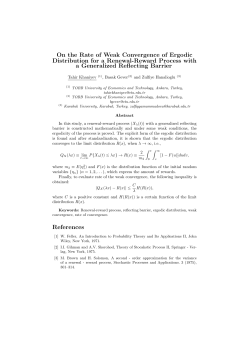
Non-Ergodic Lotka-Volterra Operators Mansoor Saburov
Non-Ergodic Lotka-Volterra Operators
Mansoor Saburov
Department of Computational & Theoretical Sciences
Faculty of Science, International Islamic University Malaysia
P.O. Box, 25200, Kuantan, Pahang, Malaysia
msaburov@gmail.com, msaburov@iium.edu.my
Pm
Let S m−1 = {x = (x1 , · · · , xm ) ∈ Rm : xi ≥ 0,
i=1 xi = 1} be the (m − 1)m−1
dimensional
standard simplex. A mapping V : S
→ S m−1 , V (x) = x0 such that
P
m
m−1
x0k =
and for all k = 1, m isPcalled a quadratic
i,j=1 pijk xi xj for all x ∈ S
stochastic operator (in short q.s.o.), where pijk = pjik ≥ 0 and m
k=1 pijk = 1 for all
i, j, k. Based on some numerical calculations, S.M. Ulam conjecturedP[1] that the
(k)
(x)
ergodic theorem holds true for any q.s.o. V , that is the limit limn→∞ n1 n−1
k=0 V
exists for any x ∈ S m−1 where V (k+1) = V ◦ V (k) . However, M.I. Zakharevich showed
[2] that Ulam’s conjecture is false in general. Namely, for the q.s.o. V : S 2 → S 2 ,
V (x) = x0P
where x01 = x21 + 2x1 x2 , x02 = x22 + 2x2 x3 , and x03 = x23 + 2x1 x3 , the limit
(k)
limn→∞ n1 n−1
(x) does not exist for any x ∈ IntS 2 \ {( 13 , 13 , 13 )}.
k=0 V
m−1
A mapping V : S
→ S m−1 is called a Lotka-Volterra operator (in short LVoperator) if every face of the simplex is invariant under V, i.e., one has that V (Sα ) ⊂
Sα for any α ⊂ {1, · · · , m} where Sα = conv{ek }k∈α and {ek }m
i=1 is the standard
basis of Rm . An LV-operator is a discrete analogy of a generalized predator-prey
model. It is worth of mentioning [3] that a q.s.o. is an LV-operator if and only if
pijk = 0 whenever k 6∈ {i, j}. In the paper [4], a necessary condition was provided
for ergodicity of q.s.o. defined on the 2D simplex. In other words, Zakharevich’s
result was generalized in some class of LV-q.s.o.
Let f : S 2 → [−1, 1] be any C 1 −smooth functional (having the first order continuous
partial derivatives). We define an LV-operator Vf : S 2 → S 2 , Vf (x, y, z) = (x0 , y 0 , z 0 )
as follows x0 = x[1 + (ay − bz)f (x, y, z)], y 0 = y[1 + (cz − ax)f (x, y, z)], z 0 =
z[1 + (bx − cy)f (x, y, z)] where a, b, c ∈ [−1, 1]. It is clear that if f ≡ const then
the LV-operator Vf is a q.s.o. which was studied in the paper [4]. In this paper, we
provide a sufficient condition in which the ergodic theorem will fail for Vf .
[1] Ulam. S.M. A collection of mathematical problems, New-York, London, 1960.
[2] Zakharevich M.I. On the behaviour of trajectories and the ergodic hypothesis for
quadratic mappings of a simplex, Russian Math Survey 33 (6) (1978), 207–208.
[3] Mukhamedov F., Saburov M. On dynamics of Lotka-Volterra type operators,
Bull. Malay. Math. Sci. Soc. 37 (1) (2014), 59–64.
[4] Ganikhodzhaev N.N., Zanin D.V. On a necessary condition for the ergodicity of
quadratic operators defined on the two-dimensional simplex, Russian Math Survey
59 (3) (2004), 161–162.
© Copyright 2025










